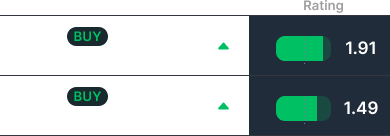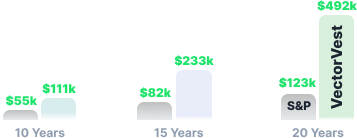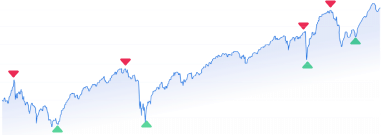While some people would love to deposit $100,000 into their first trading account, this is rarely the reality for swing traders starting out. When first getting started, you’ll likely want to dip your toes in the water with a smaller account. This is a great way to make your mistakes “smaller” when you’re first learning the ins and outs of this trading strategy.
And while you may start small, you’ll watch your account grow and flourish over time when you employ the right swing trading strategy. This is when trading starts to get really fun.
With that said, swing trading with a small account does have its limitations. There are some things you’ll need to keep in mind to be successful and reach that vision you have of a large, diversified account. Don’t worry – we’re going to unpack everything you need to know before getting started. We’ll talk about the pros and cons of small account trading, and provide you with some advice to set you up for success.
Featured Courses:
First things first – what is considered a “small account”?
What Is Considered A “Small Account”?
When talking about capital, what’s “small” to some people may be a lot to others. Similarly, what you deem to be a large amount of capital is pennies to an experienced, veteran trader who has put in the work to grow their account. That’s why it’s tough to put a dollar amount on what is considered a “small account”.
However, we see many new traders start small with just $1,000 in their accounts. This is a pretty good starting place for new traders because your risk is pretty limited. For the purpose of this article, we’ll assume you’re starting with somewhere between $1,000-5,000 in your account. If you’re starting with slightly less or slightly more, the same principles will apply.
Before we proceed: we want to stress the importance of only trading with money you don’t need. If you can’t stomach the thought of watching that $1,000 dwindle away, you might not be ready to start trading. You may need to start even smaller, or you may need to consider paper trading with fake money for a bit until you’re more comfortable.
The Benefits Of Swing Trading With A Small Account
If you’re not familiar with what swing trading is, allow us to give you a quick introduction or refresher. This style involves capitalizing on the “swings” in a stock’s price. It’s a short-term to mid-term trading style where traders get in and out of a position over the course of a few days – or at most, a few weeks. It’s great because it takes up less time than day trading, but allows for quicker results than long-term position trading.
And when it comes to trading with a small account, there are a few benefits worth mentioning.
First and foremost, you’ll watch your account grow fast. While you’re starting small, a few wins early on can make a huge impact on your account size. And with skin in the game – albeit small – you start to gauge whether trading is or is not for you. This is something you cannot replicate with paper trading. The way you feel after winning a trade – and, the way you feel after losing a trade – is something you have to experience with real money. And starting small is a great way to do that.
Secondly, a blowup isn’t damaging. Let’s face it – you’re going to make mistakes starting out, even with ample paper trading experience. You’re not going to go hungry losing a $500 trade, or even a $1000 trade. Sure, it’s no fun – but you can learn from the experience and keep moving. A blowup in a large account is far more damaging. Even small mistakes – like using the wrong type of order – won’t cost you a ton. These are the mistakes you want to learn cheaply.
The third benefit of small account trading is that you’re forced to be ultra-selective with your trades. You don’t have as much ammunition, so the trades you make need to be great opportunities. This creates big wins. And, you’ll learn proper risk management, too.
The Drawbacks Of Swing Trading With A Small Account
As you can see, there are all sorts of advantages to starting with a small account. Make no mistake, though, there are some drawbacks you should be aware of too. First of all, you have less of a buffer from the mistakes you incur. Let’s say you have a $1,000 account, and you identify two great opportunities – you put 20% of your capital into each of them. If neither one pans out how you had hoped, your account could dwindle by up to 40%.
And you also need to factor in the margins required to trade your account. Most brokerage services will require a certain amount in your account at all times. If you take a few losses in a row, your account may become untradeable until you add more funds. This adds a sense of pressure that you wouldn’t feel in a $10,000 account. You’ll also experience limitations in the types of markets you can legally trade – and how you go about trading them. Bigger accounts have fewer restrictions in this regard.
The drawbacks of trading with a small account can more or less be summarized as limitations. You’ll experience far more flexibility in trading with a larger account. But the reality is, most new traders are going to start small just based on resources and risk.
You may not have the capital to deposit $10k into your account – and even if you do, you may not feel comfortable diving in with this much capital. And that’s ok. There are countless instances of traders who began with under $500 and worked their way up to respectable account sizes.
Want to be next? With our advice and the right tools, you can make your vision a reality.
Our Advice For Those Swing Trading With A Small Account
Swing trading small accounts requires one to practice strict measurement of opportunity cost – by measuring risk and maximizing the opportunity of each trade. You’ll need to leverage the right tools, too. Here are a few pieces of advice we want to offer any new trader getting started with a small account:
Keep Your Capital Working Around The Clock
First and foremost, you need to keep your capital working at all times when market conditions are favorable. When starting out with a smaller account, you want to make sure that $1,000 you have at your disposal is being utilized. With a bigger account, you may have a large chunk of cash sitting around as you wait for an opportunity. But you cannot afford to do this with a smaller account. We recommend you have up to 80-100% of your capital leveraged in positions at any given time.
Don’t Pass Up Profits
Picture this – you found the perfect opportunity to swing trade. You get in at a good time and over the course of a few days, the stock does exactly what you expect it to do – the price swings up. While you may see the potential for another 5-10% profit, we highly encourage you to get out with your profit while you can. There is no worse feeling for small account traders than watching profit potential dwindle away. It won’t just do damage to your account – it will damage your psyche, which is the last thing you want as a new, inexperienced trader.
Better yet, eliminate any human error/emotion from the jump by setting a take-profit order. You can set the target for which you want to close your position at – be it a 5% gain, 10% gain, or more. Whatever you do, take profits!
Avoid Jumping Into Just “Any” Opportunity
Remember – you need to be ultra-strategic with where you disperse the limited capital you have. We’re not looking for “just okay” opportunities. We need big wins to start growing your account. So, set your standards high when following your swing trading indicators. Find opportunities that will actually move the needle for you.
Sure, you can settle for slow, low-risk growth – but you’re going to be stuck in a small account for a long while. Instead, find opportunities that check off all the boxes of your trading strategy and have the potential to yield at least 10% returns.
Make Sure You Have The Right Tools In Your Arsenal
Trading is hard enough as it is – with a smaller account, it will be even harder. You can’t afford much room for error. That’s why you need to set yourself up for success by having the right tools in your arsenal. A stock analysis software is a must. This type of tool will help you effectively time the market so you know when to get in, and when to get out.
And here at VectorVest, we’ve developed the most intuitive software on the market. We tell you when to buy, what to buy, and when to sell – it’s that simple. You can simply take a look at our top-rated stocks for any given day and see if they meet your criteria. We make investing simple by offering a clear buy, sell, or hold recommendation for any given stock. If you want to see what it looks like in action, take a look at our free stock analysis.
With VectorVest in your arsenal, you’ll watch those wins stack up and your account grow. Soon, you’ll be able to invest in confidence knowing you have the best information possible at any given time.
Final Thoughts On Swing Trading With A Small Account
Swing trading with a small account isn’t the ideal situation – but it does come with its own set of advantages. And with the right information, your account won’t stay small for long. So, take action today and get started! Just remember:
- Keep your capital working
- Don’t pass up profits
- Be strategic with the opportunities you open a position in
- Leverage software to help you make sense of investing – especially as you get started
Take all of the guesswork, emotion, and human error out of trading with VectorVest. We’ve been calling every major market move for the past 20 years, and continue to help our traders stay on the right side of their trades.
Featured Courses:
What you should do next…
- Get our latest blogs delivered right to your inbox, subscribe to our newsletter.
- The market moves fast! Get our most current evaluation of this stock with our FREE stock analysis tool.
- Looking for stock picks? Not sure if now is the right time to buy/sell? For a limited time, enjoy the full benefits of a 30-day subscription to VectorVest for only [offer_txt] (usually up to [saving_txt]/month) . Get access to our full list of screeners showcasing our top stock picks that tell you exactly what to buy, when to buy, and when to sell.












